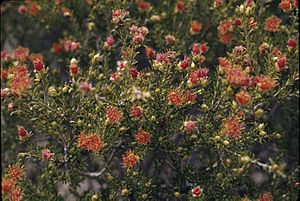Rusty eremaea facts for kids
Quick facts for kids Rusty eremaea |
|
|---|---|
 |
|
| Conservation status | |
| Scientific classification | |
| Genus: |
Eremaea (plant)
|
| Species: |
acutifolia
|
| Synonyms | |
|
Melaleuca acrifolia Craven & R.D.Edwards |
|
The rusty eremaea (Eremaea acutifolia) is a special plant found only in the south-west part of Western Australia. It belongs to the myrtle family, which includes many well-known Australian plants. This small shrub has leaves that look like needles and beautiful orange flowers. When it grows fruit, they feel rough to the touch.
Contents
What Does the Rusty Eremaea Look Like?
The rusty eremaea is a shrub that can grow up to about 0.7 meters (about 2.3 feet) tall. Its leaves are long and thin, like needles. They are usually between 3.6 and 9.5 millimeters (about 0.14 to 0.37 inches) long and 0.5 to 1.2 millimeters (about 0.02 to 0.05 inches) wide. You can see a clear vein on the underside of each leaf.
Its Flowers and Fruits
The flowers of the rusty eremaea are usually orange, but sometimes they can be a dark pink. They grow on short branches that grew the year before. Usually, there is one flower, but sometimes two can grow together. Each flower has five sepals (small leaf-like parts that protect the bud) that are hairy on the outside. It also has five petals, which are about 3 to 4 millimeters (about 0.12 to 0.16 inches) long.
Inside the flower, the stamens (the parts that make pollen) are grouped into five bundles. Each bundle has between 28 and 34 stamens. The rusty eremaea flowers from August to November. After the flowers, it grows woody fruits called capsules. These capsules are shaped like an upside-down cone and are about 3.5 to 6 millimeters (about 0.14 to 0.24 inches) long. Their outer surface feels rough or lumpy.
How It Got Its Name
The rusty eremaea was first officially described in 1860 by a scientist named Ferdinand von Mueller. He wrote about it in a book called Fragmenta Phytographiae Australiae.
The plant's scientific name, acutifolia, comes from two Latin words. Acutus means "sharp" or "pointed," and folium means "a leaf." This name describes the plant's pointed leaves.
Where Does It Grow?
The rusty eremaea is only found in a small area of Western Australia. This area is east of a city called Geraldton. It grows in sandy soil on flat, open areas called sandplains. These areas are part of the Avon Wheatbelt and Geraldton Sandplains regions.
Is It Protected?
The Western Australian Government's Department of Parks and Wildlife has given the rusty eremaea a "Priority Three" classification. This means that scientists don't know a lot about this plant, and it's only found in a few places. However, it is not currently in immediate danger of disappearing.
Images for kids



